Ruminating on why the 1918 flu pandemic wasn’t better remembered, the African historian Terence Ranger concluded in the early 2000s that the story wasn’t being told right. The vast majority of the victims—50 million of them at a conservative count—perished in a mere 13 weeks at the tail end of 1918, all over the globe. It was a planetary convulsion that was over in the blink of an eye, but whose impact reverberated through human societies for decades to come.
That kind of story doesn’t fit a linear narrative, Ranger thought. You need something rounder, more concentric; something close to the way he’d heard women in southern Africa rehearse an event that mattered to them. “They describe it and then circle around it,” he wrote, “constantly returning to it, widening it out and bringing into it past memories and future anticipations.” They take the weft of the event and draw it through the warp of their communal memory, until the two are woven together.
There is another way in which gender shapes our memory of the 1918 flu. Though more men than women died in that pandemic, women generally nursed the ill—and given the state of medical science at the time, their efforts were often what determined whether a patient lived or died. It was the women who registered the sights, sounds, and smells of the sickroom. Crucial eyewitnesses, they were the ones who connected the personal tragedies with the public memory; but with relatively few exceptions, their voices haven’t properly been heard. In her new novel, The Pull of the Stars, Irish-Canadian writer Emma Donoghue imagines what they would say if they could speak to us. She takes us into the sickroom, at whose door—out of respect or disgust or fear—the narrator usually stops.
The task couldn’t have fallen to a better-qualified artist. In a previous novel, Room (2010), Donoghue examined the relationship between a mother and her child who live in what is essentially a 3-meter-square prison cell. “I wanted to focus on how a woman could create normal love in a box,” she told a visiting journalist when it was published. In The Pull of the Stars, too, she conjures up a claustrophobic space—an overflow “Maternity/Fever” ward at a Dublin hospital, a converted supply room that just about accommodates three cots. And into it she brings the world.
Read all of our coronavirus coverage here.
The world, as is its wont, comes in different shapes and sizes. There are the occupants of the cots—a shifting cast

